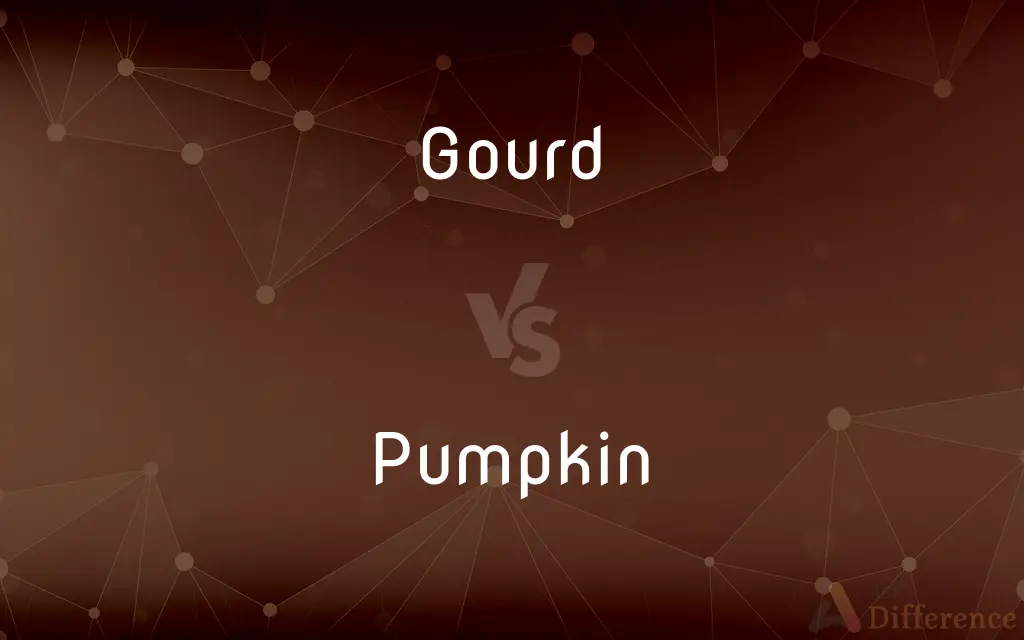Gourd vs. Pumpkin — What's the Difference?
By Tayyaba Rehman — Updated on October 30, 2023
Gourds are generally decorative and inedible, with a hard shell, while pumpkins are edible, with soft flesh and are often used in cooking.

Difference Between Gourd and Pumpkin
Table of Contents
ADVERTISEMENT
Key Differences
Gourds belong to the Cucurbitaceae family, characterized by hard shells and varied shapes. They are mainly used for ornamental purposes or as utensils. Pumpkins, also part of the Cucurbitaceae family, are known for their soft, edible flesh and are commonly used in culinary dishes.
Gourds are diverse, ranging from tiny to very large, with skin that can be smooth, warty, or ridged. In contrast, pumpkins typically have a smooth, ribbed exterior, and their size is usually more uniform, being medium to large.
While gourds are often grown for decorative purposes, crafting, or as containers, pumpkins are cultivated primarily for consumption, with their seeds and flesh being edible. Pumpkins are also a symbol of fall and are commonly used in Halloween decorations.
Gourds are typically inedible due to their hard, bitter flesh, and are valued for their aesthetic qualities. Pumpkins, on the other hand, are celebrated for their sweet, orange flesh, used in pies, soups, and other dishes.
In summary, gourds are more varied in appearance and are used for decoration, while pumpkins are grown for their edible qualities and play a significant role in fall festivities and cuisine.
ADVERTISEMENT
Comparison Chart
Edibility
Generally inedible
Edible
Usage
Decorative, utensils
Cooking, Halloween decorations
Shell/Flesh
Hard shell, bitter flesh
Soft flesh, sweet flavor
Varieties
Highly diverse in shape and size
More uniform, medium to large
Cultural Significance
Craft and ornamentation
Integral to fall cuisine and decor
Compare with Definitions
Gourd
A fruit with a hard shell, typically inedible.
The gourd was beautifully painted and used as a decoration.
Pumpkin
A large, round, orange fruit with a thick rind and edible flesh.
We carved faces into the pumpkin for Halloween.
Gourd
Any plant of the family Cucurbitaceae with hard-shelled fruits.
Gourd vines are climbing up the trellis in the garden.
Pumpkin
The plant that produces large orange fruits, used in cooking.
Her garden is full of pumpkin vines.
Gourd
A symbol or representation of harvest and autumn.
Gourds are often used in fall decorations.
Pumpkin
The flesh of the pumpkin used as food.
She made a delicious pumpkin pie.
Gourd
A container or utensil made from the dried shell of a gourd.
He drank water from a gourd he carved himself.
Pumpkin
A symbol of Halloween and autumn celebrations.
Pumpkin decorations are all around during the fall season.
Gourd
A decorative object made from the shell of a gourd.
The table centerpiece was a gourd artfully carved into a bird.
Pumpkin
A pumpkin is a cultivar of winter squash that is round with smooth, slightly ribbed skin, and is most often deep yellow to orange in coloration. The thick shell contains the seeds and pulp.
Gourd
Gourds include the fruits of some flowering plant species in the family Cucurbitaceae, particularly Cucurbita and Lagenaria. The term refers to a number of species and subspecies, many with hard shells, and some without.
Pumpkin
A round, often large squash with coarse, strongly flavored yellow to orange flesh, numerous seeds, and a moderately hard, usually orange rind.
Gourd
Any of several trailing or climbing cucurbit plants bearing fruits with a hard rind, especially Lagenaria siceraria and a variety of Cucurbita pepo.
Pumpkin
Any of several plants producing these fruits, especially varieties of the species Cucurbita pepo, and also varieties of C. maxima and C. moschata.
Gourd
The fruit of such a plant, sometimes of unusual shape or color.
Pumpkin
A moderate to strong orange.
Gourd
The dried and hollowed-out shell of one of these fruits, often used as a container or as a decorative object.
Pumpkin
A domesticated plant, in species Cucurbita pepo, similar in growth pattern, foliage, flower, and fruit to the squash or melon.
Gourd
Any of the trailing or climbing vines producing fruit with a hard rind or shell, from the genera Lagenaria and Cucurbita (in Cucurbitaceae).
Pumpkin
The round yellow or orange fruit of this plant.
Gourd
A hard-shelled fruit from a plant in Lagenaria or Cucurbita.
Pumpkin
(uncountable) The color of the fruit of the pumpkin plant.
Gourd
The dried and hardened shell of such fruit, made into a drinking vessel, bowl, spoon, or other objects designed for use or decoration.
Pumpkin
(Australia) Any of a number of cultivars from the genus Cucurbita; known in the US as winter squash.
Gourd
(obsolete) Any of the climbing or trailing plants from the family Cucurbitaceae, which includes watermelon, pumpkins, and cucumbers.
Pumpkin
(US) A term of endearment for someone small and cute.
Gourd
(informal) loaded dice.
Pumpkin
A well-known trailing plant (Cucurbita pepo) and its fruit, - used for cooking and for feeding stock; a pompion.
Gourd
(slang) Head.
I got so stoned last night. I was out of my gourd.
Pumpkin
A coarse vine widely cultivated for its non-keeping large pulpy round orange fruit with firm orange skin and numerous seeds; subspecies of Cucurbita pepo include the summer squashes and a few autumn squashes
Gourd
A fleshy, three-celled, many-seeded fruit, as the melon, pumpkin, cucumber, etc., of the order Cucurbitaceæ; and especially the bottle gourd (Lagenaria vulgaris) which occurs in a great variety of forms, and, when the interior part is removed, serves for bottles, dippers, cups, and other dishes.
Pumpkin
Usually large pulpy deep-yellow round fruit of the squash family maturing in late summer or early autumn
Gourd
A dipper or other vessel made from the shell of a gourd; hence, a drinking vessel; a bottle.
Pumpkin
An affectionate term for someone or something dear.
Goodnight, pumpkin, she said to her child.
Gourd
A false die. See Gord.
Gourd
A silver dollar; - so called in Cuba, Haiti, etc.
Gourd
Bottle made from the dried shell of a bottle gourd
Gourd
Any of numerous inedible fruits with hard rinds
Gourd
Any vine of the family Cucurbitaceae that bears fruits with hard rinds
Common Curiosities
What's the typical use of gourds?
Decorative purposes and as utensils.
Are all gourds inedible?
Most are, due to their hard, bitter flesh, but some varieties are edible.
Can pumpkins be used for decoration?
Yes, especially during Halloween and fall.
Do gourds have any culinary use?
Generally no, they're mainly used for decoration.
Is pumpkin used in any traditional dishes?
Yes, especially in pies, soups, and bread.
Can pumpkins vary in color?
Yes, they can be orange, white, green, and more.
Are pumpkins healthy to eat?
Yes, they are nutritious and rich in vitamins.
Can gourds be dried and preserved?
Yes, they are often dried and used as containers or decorations.
Can you carve a gourd like a pumpkin?
Yes, but they are harder due to their thick shell.
Is pumpkin a fruit or a vegetable?
Botanically, it's a fruit because it develops from a flower.
What's the main difference in taste?
Gourds are bitter, while pumpkins are sweet.
Is the term 'gourd' used metaphorically?
Not typically, it's usually used in a literal sense.
Do gourds come in different shapes?
Yes, they vary greatly in shape and size.
Are pumpkins used in any festivals?
Yes, especially during Halloween and Thanksgiving.
Are there any edible gourds?
Yes, but they are less common than the decorative ones.
Share Your Discovery

Previous Comparison
Fitter vs. Nitter
Next Comparison
Lesson vs. SubjectAuthor Spotlight
Written by
Tayyaba RehmanTayyaba Rehman is a distinguished writer, currently serving as a primary contributor to askdifference.com. As a researcher in semantics and etymology, Tayyaba's passion for the complexity of languages and their distinctions has found a perfect home on the platform. Tayyaba delves into the intricacies of language, distinguishing between commonly confused words and phrases, thereby providing clarity for readers worldwide.














































